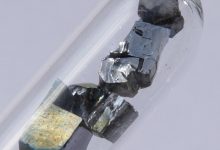Australian Vanadium will build its high purity vanadium electrolyte manufacturing facility in the Perth suburb of Wangara, as the company expects vanadium redox flow (VFRB) adoption to surge in Australia.
The factory is on track for commissioning in September this year, provided equipment ordered from the vanadium supplier US Vanadium arrives on time.
It is also on track to meet the budget expectations made in 2021 of $7.4 million, CEO Graham Arvidson told RenewEconomy.
The company has a grand plan to process the minerals mined at its yet-to-be commissioned Australia Vanadium Project at Garabintha, near Meekatharra in Western Australia, and then turn it into the fuel its energy storage subsidiary VSUN Energy needs for its vanadium redox-flow batteries.
“The company plans to explore opportunities to replicate this electrolyte facility on the east coast of Australia, to supply additional electrolyte for VRFB projects slated to be deployed in a variety of States and Territories,” Arvidson said in a statement.
The factory will be able to produce up to 33MWh per year of high purity electrolyte, and use technology from US Vanadium, for which Australian Vanadium holds the local licence to use.
About 70 litres of electrolyte is needed to generate one kWh, and about 6600 pounds of vanadium pentoxide equivalent is required to make a 300 kWh battery.
“As a practical example, the battery we are installing with [battery metals miner] IGO is 300kWh – this means there would be approximately 21,000 litres of electrolyte in the battery,” Arvidson says.
US Vanadium will also supply the vanadium pentoxide feedstock needed to make the electrolyte while the mine is still being developed.
Last year the company said it should have a final investment decision for the mine in the December quarter, but is yet to deliver that. Arvidson says the bankable feasibility study’s 2025 date is the best interim clue to a commissioning timeline.
Demand for VRFBs growing – outside Australia
Australia is yet to embrace the VFRB, as energy companies prefer to use the more popular lithium ion batteries for large scale storage.
But with long duration storage gaining the backing of governments across the country — in December federal and state energy ministers agreed on a new mechanism to support long duration storage — the tested technology of VFRBs might be attractive.
Compressed air storage, gravity batteries, graphite batteries and the revival of solar thermal power are all being tested, or seeking investment so they can be built, in Australia.
But Arvidson believes it will be the 30-year track record of the technology that will allow VFRBs to surpass these alternatives.
“VSUN Energy has been building a pipeline for the last three to four years,” he told RenewEconomy.
“The biggest opportunity will be east and west coast power providers looking to shift energy in four to six hour blocks.”
He believes the anticipated September start date for the factory will allow VSUN Energy to emerge as a VFRB player just as adoption of the technology has hit a “step change”.
“If you look at what’s happened in the last 12 months, more VFRB batteries were sold globally than in the last 30 years combined,” he said.
“Last year about 2 per cent of vanadium went into batteries, this year the conservative guys are saying it’s now between 10 per cent and 15 per cent of the global vanadium market. That is a pretty profound step change.”
China is driving the change, connecting a 100 MW/400 MWh VFRB to the grid in Dalian, in September.
Industry analyst Argus Media is forecasting China’s vanadium demand from VFRBs alone to touch at least 9,100t of V2O5 (vanadium pentoxide) equivalent in 2022, up 88 per cent on 2021 and up 219 per cent on 2020.
VSUN Energy has been chipping away at the residential market and has been aiming for bigger use cases, installing a trial 5kW/30kWh battery at the WA Water Corporation’s research precinct in January 2020, and trialling VFRB use in WA electric vehicle charge stations in 2021.










